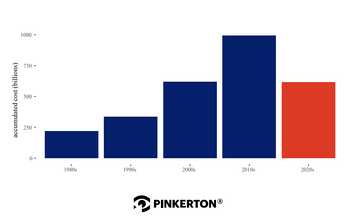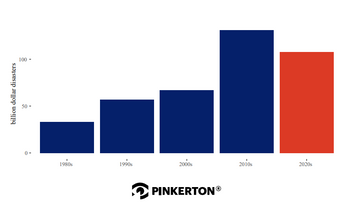In the wake of Hurricane Helene’s broad swath of devastation across the American southeast, millions were without power, more than 230 people are dead with more still missing. Rescue crews were seeking to help the missing, injured, and isolated with food, water, and supplies. Restoration of roads and power across the Carolinas, Florida, Georgia, and Tennessee is likely to take weeks. The recovery and clearance of the devastation will take longer.
Despite Hurricane Milton’s landfall being less devastating than many predictions, the rapid occurrence of two hurricanes left broad challenges with millions of Florida residents without power. Early estimates project that Hurricane Milton may have produced USD 50 billion in losses, in addition to the nearly 20 confirmed deaths.
Hurricane Helene already ranks among the deadliest and most destructive hurricanes in recorded American history, drawing comparisons to Katrina (2005), Harvey (2017), Ian (2022), and Sandy (2012). AccuWeather’s estimated damage and economic losses from recent natural disasters in the U.S. caused by Hurricane Helene is currently USD 225 billion to USD 250 billion.
The Escalating Cost of Natural Disasters
The frequency of, and devastation and deaths associated with, major natural disasters in America have increased since the turn of the century. The National Oceanic and Atmospheric Administration (NOAA) has tracked billion-dollar natural disaster events since the 1980s. The data collected surrounding these events exclude the costs incurred by smaller events but serve as a powerful indicator of the challenges brought by climate events. The financial toll of all types of billion-dollar disasters from 1980-2024 (excluding Hurricane Helene and Hurricane Milton) is USD 2,781.1 billion. When broken down by decade and adjusted for inflation, an unsettling trend emerges.

The 2020s, nearing the decade’s halfway mark, have already eclipsed inflation-adjusted total costs for the 1980s and 1990s and are a mere 4 billion dollars behind the total accumulated cost of disasters for the 2000s, prior to the landfall of Hurricanes Helene and Milton. The year 2023 was record-setting for disasters — there were 28 recorded billion-dollar disasters, replacing the prior record of 22 in 2020. Climate disasters in 2023 also caused 492 deaths, the 8th most fatalities in a single year since 1980.
Out of 20 of California’s largest wildfires, 19 have occurred since 2001. Five of them occurred in 2020. Four of them occurred in 2021. The Park Fire from July 2024 stands as the 4th largest fire in California history and damages are still being tabulated.
The Changing climate of Disaster Frequency
NOAA’s tabulations include seven types of weather events: Drought, flooding, freeze, severe storms, tropical cyclones, wildfires, and winter storms. These events can occur annually. NOAA’s statistics show that from 1980-2024, they happened at a pace of about 8.8 per year, with severe storms occurring most frequently, followed by tropical cyclones as the second most common. The frequency of these large-scale disasters is increasing.

There is no single factor chiefly responsible for the increasing toll of damage. Instead, the confluence of several factors contributes to the growing devastation. Increasing populations and centers of economic activity are situated in areas vulnerable to these disasters. According to the U.S. Census Bureau, as of 2017 60.2 million people — about 18% of the total population — live in areas extremely vulnerable to hurricanes. The distribution of Americans living on the coastline has grown over 15% since the year 2000.
According to the U.S. Fire Administration, almost 99 million people, one-third of the U.S. population, live in the Wildland Urban Interface (WUI), where human communities and settlements about the wilderness. This includes some 70,000 communities, with 46 million homes at an estimated value of 1.3 trillion dollars, in heightened wildfire risk areas. From 1990 to 2010, WUI across America grew by an estimated 33%.
The Role of Out-of-Season natural Disasters
Both hurricanes and wildfires have shown out-of-season activity over the past several years. Hurricane season is officially marked from June 1 through November 30. There have been five named tropical cyclones out of season that impacted American coastal communities in the last decade
Dry winter seasons have produced several historically large wildfires out of season. The Smokehouse Creek Fire in Texas in February 2024 burned over one million acres and killed 33 people. It is the largest fire in Texas’ recorded history. In Colorado, the Marshall Fire, late December 2021, killed two people and destroyed almost 1000 structures, producing more than USD 2 billion in damages.
The Role of Advances Risk Assessment for Disaster Preparedness
Concentrations of populations and economic activity centers, out-of-season storms, and aging infrastructure all play roles in increasing the toll of natural disasters in the 21st century.
Every community in America is exposed to natural disaster risk. Conscientious and intelligent planning can help to mitigate devastation and produce stronger business continuity. The Pinkerton Risk Pulse provides site-specific risk assessments for varying facets of risk, driven by advanced algorithms and proprietary data analysis methodologies, creating a detailed portrait of natural disaster risk down to the neighborhood level.
Additionally, Pinkerton is an industry leader in crisis management and disaster response planning services to help you understand how to prepare for and respond to billion-dollar hurricanes.
PINKERTON. WE NEVER SLEEP.
Cohen, D. (2021, October 28). About 60.2m live in areas most vulnerable to hurricanes. Census.gov. https://www.census.gov/library/stories/2019/07/millions-of-americans-live-coastline-regions.html
Daniele, M. (2024, September 30). Helene aftermath: More than 130 dead, historic flooding, millions without power amid catastrophic destruction. https://www.accuweather.com/en/hurricane/helene-aftermath-more-than-130-dead-historic-flooding-millions-without-power-amid-catastrophic-destruction/1697545
Karels, J.R. (2022, June). Wildland Urban Interface: A Look at Issues and Resolutions. FEMA and U.S. Fire Administration. https://www.usfa.fema.gov/downloads/pdf/publications/wui-issues-resolutions-report.pdf
NOAA National Centers for Environmental Information (NCEI) U.S. Billion-Dollar Weather and Climate Disasters (2024). https://www.ncei.noaa.gov/access/billions/, DOI: 10.25921/stkw-7w73
Smith, A. B. (2024, January 8). 2023: A historic year of U.S. billion-dollar weather and climate disasters. Climate.gov. https://www.climate.gov/news-features/blogs/beyond-data/2023-historic-year-us-billion-dollar-weather-and-climate-disasters#:~:text=The%20number%20and%20cost%20of,and%20the%20fact%20that%20climate
Wee, L. K. (n.d.). Hurricane Milton might cost insurers up to $50 billion - but it could have been much worse, analysts said. Business Insider. https://www.businessinsider.com/hurricane-milton-insurance-fitch-50-billion-losses-2024-10





